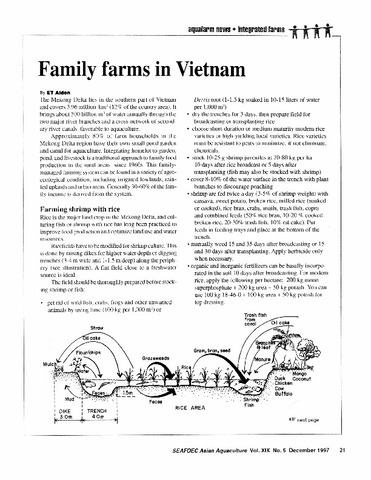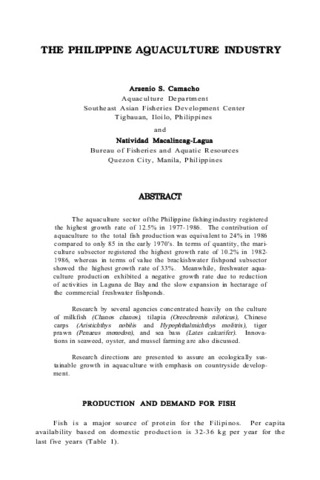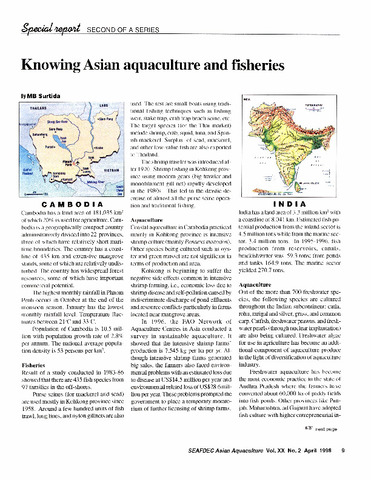| dc.contributor.author | Liang, Bing | |
| dc.contributor.author | Neo, He Sheng | |
| dc.contributor.editor | Aya, Frolan A. | |
| dc.contributor.editor | de la Peña, Leobert D. | |
| dc.contributor.editor | Salayo, Nerissa D. | |
| dc.contributor.editor | Tendencia, Eleonor A. | |
| dc.date.accessioned | 2021-12-16T02:51:18Z | |
| dc.date.available | 2021-12-16T02:51:18Z | |
| dc.date.issued | 2021-12 | |
| dc.identifier.citation | Liang, B., & Neo, H. S. (2021). Country report—Singapore. In F. A. Aya, L. D. de la Peña, N. D. Salayo, & E. A. Tendencia (Eds.), Proceedings of the International Workshop on the Promotion of Sustainable Aquaculture, Aquatic Animal Health, and Resource Enhancement in Southeast Asia (pp. 171–178). Tigbauan, Iloilo, Philippines: Aquaculture Department, Southeast Asian Fisheries Development Center. | en |
| dc.identifier.isbn | 9789719931102 (Print) | |
| dc.identifier.isbn | 9789719931119 (PDF) | |
| dc.identifier.uri | http://hdl.handle.net/10862/6270 | |
| dc.description.abstract | The aquaculture industry produces about 10 % of Singapore’s annual local fish consumption. By 2030, the country’s goal is for the agri-food industry to produce 30 % of Singapore’s nutritional needs. In order to achieve this, the Marine Aquaculture Centre (MAC) spearheaded several research and development programmes such as the broodstock development of Asian seabass and large-scale fry production technology. MAC also provides technical support to local farms to adopt sustainable farming practices and technology. In 2019, the Singapore Food Agency (SFA) was formed to oversee all matters pertaining to food supply and safety, including seafood production from aquaculture. The National Centre for Food Safety (NCFS) of SFA and Centre for Animal and Veterinary Services (CAVS) under National Parks Board (NParks) provides support via their diagnostic and testing capabilities in the areas of food safety and animal health, respectively.
Based on the national surveillance program conducted by the SFA and NParks, the commonly reported diseases are viral, bacterial or parasitic infections. These include Benedeniosis, Big-Belly (BB) Disease Syndrome, infections with Streptococcus iniae and Tenacibaculum maritimum, Norcardiosis, Viral Nervous Necrosis (VNN), and Infectious Spleen and Kidney Necrosis Virus (ISKNV). With the aim to control and manage the aquatic diseases in Singapore, control measures for major pathogens in fin fishes and crustaceans are being implemented. In addition, Aquatic Animal Health Professionals (AAHP) should undergo trainings in aquaculture farm biosecurity. | en |
| dc.language.iso | en | en |
| dc.publisher | Aquaculture Department, Southeast Asian Fisheries Development Center | en |
| dc.rights | Attribution-NonCommercial-ShareAlike 3.0 IGO | * |
| dc.rights.uri | http://creativecommons.org/licenses/by-nc-sa/3.0/igo/ | * |
| dc.subject | Singapore | en |
| dc.title | Country report - Singapore | en |
| dc.type | Conference paper | en |
| dc.citation.spage | 171 | |
| dc.citation.epage | 178 | |
| dc.subject.asfa | aquaculture | en |
| dc.subject.asfa | aquaculture economics | en |
| dc.subject.asfa | aquaculture systems | en |
| dc.subject.asfa | research | en |
| dc.subject.asfa | disease control | en |
| dc.citation.conferenceTitle | Proceedings of the International Workshop on the Promotion of Sustainable Aquaculture, Aquatic Animal Health, and Resource Enhancement in Southeast Asia | en |




